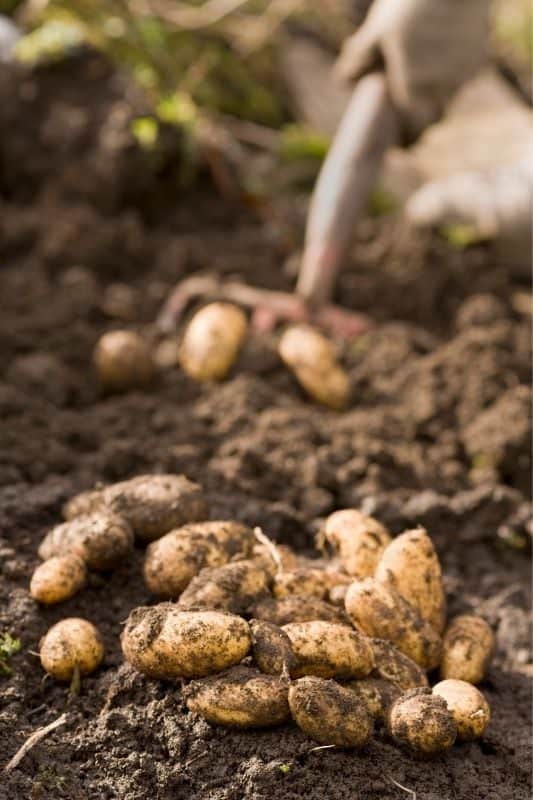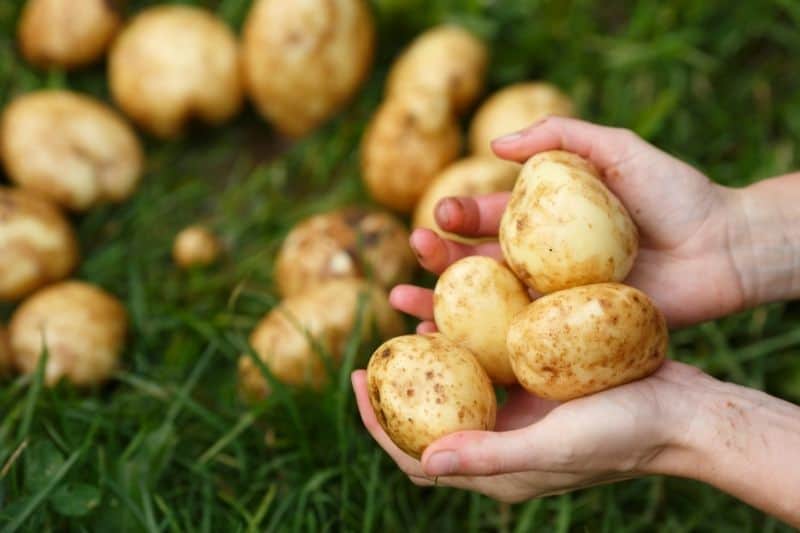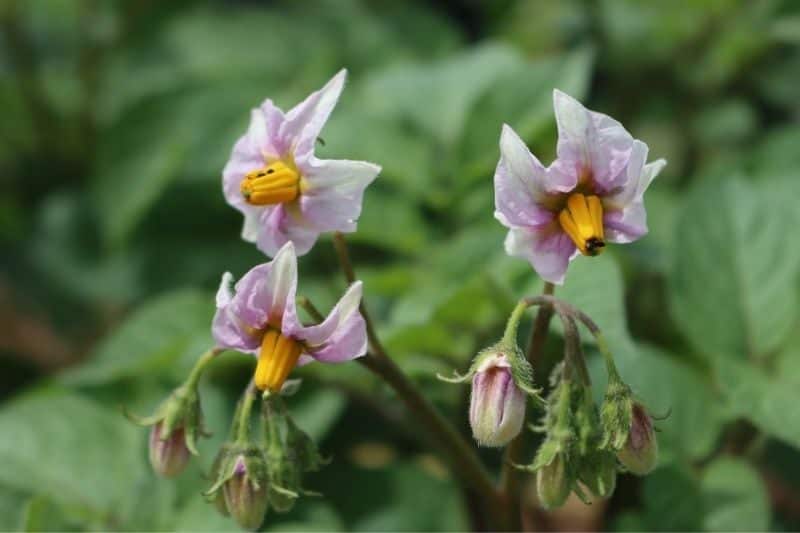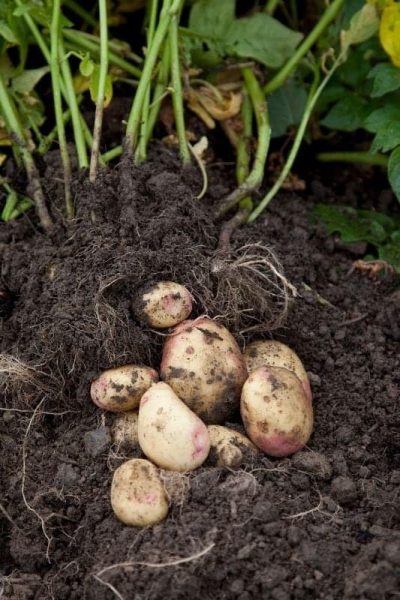Want to grow your own potatoes? The time it takes to grow potatoes depends on their variety, the climate, and the amount of sunlight.
What month do you plant potatoes?
You can plant potatoes as soon as the soil warms to 45°F and can be worked easily. For most people, this is two weeks after the last frost date. Monitor soil moisture as well. If the spring has been very wet, it’s better to wait a few weeks for the ground to dry up slightly because wet, cold soil can cause the tubers to rot in the ground.
If you want to plant your potatoes earlier, look for early maturing varieties that can withstand cold better. Planting one of these varieties could get your potatoes in the ground as early as six weeks before the last frost date.

How long does it take to grow potatoes?
There are three main types of potatoes—early season, mid-season, and late season. Early season potatoes will be ready for harvest 50 to 70 days after planting. Mid-season varieties will be ready between 95 and 110 days, and late-season potatoes will take at least 110 days to harvest. Which potato variety you choose will depend on the length of your growing season.
Varieties to try when growing potatoes
There are hundreds of potato varieties available through garden centers and seed catalogs. Before choosing one, think about things like the length of your growing season, how much space you have available, culinary uses—low starch versus high starch—and disease resistance. Once you have an idea of what you need from your potato, look at the following popular potato varieties to see which one matches your needs best.
- Red Norland—An early variety that only takes 70 days to mature from planting. Norland potatoes are one of the most popular red-skinned potatoes available. They’re well suited to boiling and roasting. They also have a thin skin, are delicious eaten fresh, and do well in storage.
- French Fingerling—A mid- to late-season potato that’s well suited to growing in small spaces such as containers. They have yellow flesh, pink skin, and a slightly sweet flavor.
- Yukon Gold—An early to mid-season variety that produces an abundant harvest of large yellow-white potatoes. Yukon gold potatoes store well and are very versatile. You can use them in almost every type of cooking and they’re one of the best potatoes for mashing.
- All Blue—A unique potato that has purple skin and blue and white flesh. This is a late-season potato variety that’s high in antioxidants. All blue potatoes are great for roasting and boiling.
- Russian Banana—One of the smallest potatoes, well suited to container gardening. Russian banana potatoes are a yellow-fleshed late variety. They’re very flavorful and do well when boiled.
- Russet—Oval-shaped potatoes with thick skin and creamy flesh. They’re fantastic for mashing, making French fries, and using in potato salads. They store well as long as long as they’re kept in a cool, dark environment.

What are seed potatoes?
Potatoes aren’t started indoors the same way vegetables that come from seeds are. The plants grow from tiny pieces of potatoes with “eyes” on them. A few days before planting, take your seed potatoes and cut them into chunks that have at least two sprouts or eyes. Cutting them will allow you to get several plantings out of each seed potato. Taking the time to do this a few days before planting allows a crust to form over the cut area, protecting the tuber when it’s planted. If your seed potatoes are smaller than a chicken egg, don’t bother cutting them. You can plant them whole.
Growfully Protip
In recent years, seed developers have come up with a potato that is grown from seeds. It’s called the Clancy Hybrid potato. You would start this unique variety indoors eight to ten weeks before you plan on planting your potatoes outside.
Can I start my potato plants indoors to get a head start?
Potatoes are very hearty, and in most areas you can plant them out as soon as the soil can be worked in early Spring or Late Winter. In general, we recommend only planting potatoes by direct sowing them. That being said, if you have a particularly short growing season, or you want to try a longer-growing variety of potato, you can try starting them indoors. To do this, follow these steps:
- Prepare your seed potatoes by cutting them into smaller pieces
- Fill a three or four inch pot with a soil compost mix and plant one tuber per pot.
- Keep the pots in a warm, sunny location and water frequently
- Once seedlings are three to four inches tall, they’re ready to be transplanted outdoors
Can I grow potatoes from a grocery store potato?
This depends on the potatoes you purchased.
If you purchased conventionally grown or foreign-grown potatoes, growers often treat these potatoes with chemicals that prevent them from sprouting and forming eyes. Even if your potatoes have formed eyes, it’s still not a good idea to use them, as you don’t know what chemicals the potatoes were treated with.
But if you purchase organic domestic potatoes (especially once from a local source like a farmers market), you can plant those potatoes and get great plants!

How many potatoes will one plant produce?
Different varieties of potatoes will produce a different yield come harvest time. As a general rule, if the plant is healthy, you can expect to dig up about five or six full-size potatoes. Every potato plant will most likely have a bunch of smaller, baby-size potatoes as well.
Are my potatoes growing?
Because potatoes do most of their growth below the surface of the soil, it’s difficult to know whether the tubers are actually growing. Flowering is a great sign that your plants have started growing tubers. After the flowering has ended, the plants above the surface die back, and all the plant’s energy goes towards creating larger tubers. While it can be tempting to dig around the plant to find out if the tubers are growing, it’s best to rein in your curiosity—it’s difficult to re-plant a potato plant that’s been dug up.

How do you know when potatoes are ready to harvest?
Potatoes are ready to harvest in two stages. The first stage is when they’re flowering. Flowering is a sign that the potatoes have grown baby tubers and it’s a great time to harvest new potatoes. You can also harvest potatoes when they’re full grown. You’ll know they’ve reached maturity when the leaves and stems have gone yellow and died off near the end of summer or early fall. If you’re unsure whether your potatoes are ready, you can gently dig around the base of the plant to gauge the size of the tubers. You can also dig up a test plant to see if the potatoes are large enough to harvest.
For more on how to harvest and cure potatoes, check out our guide to harvesting potatoes.








Will this work for sweet potatoes also
No, sweet potatoes are a different plant and will take a different amount of time to grow.